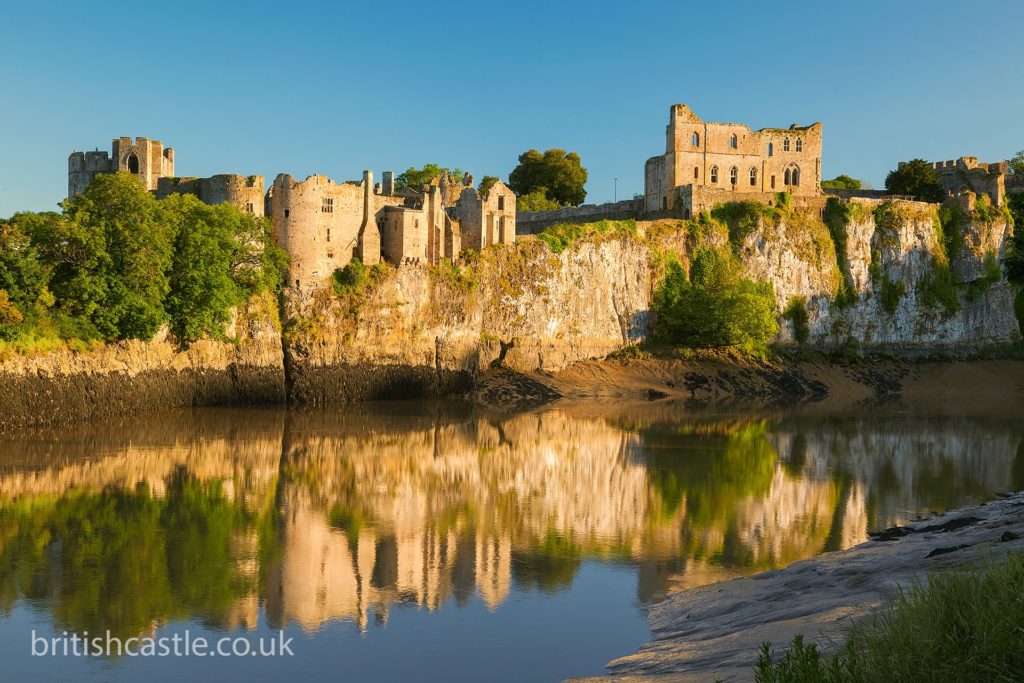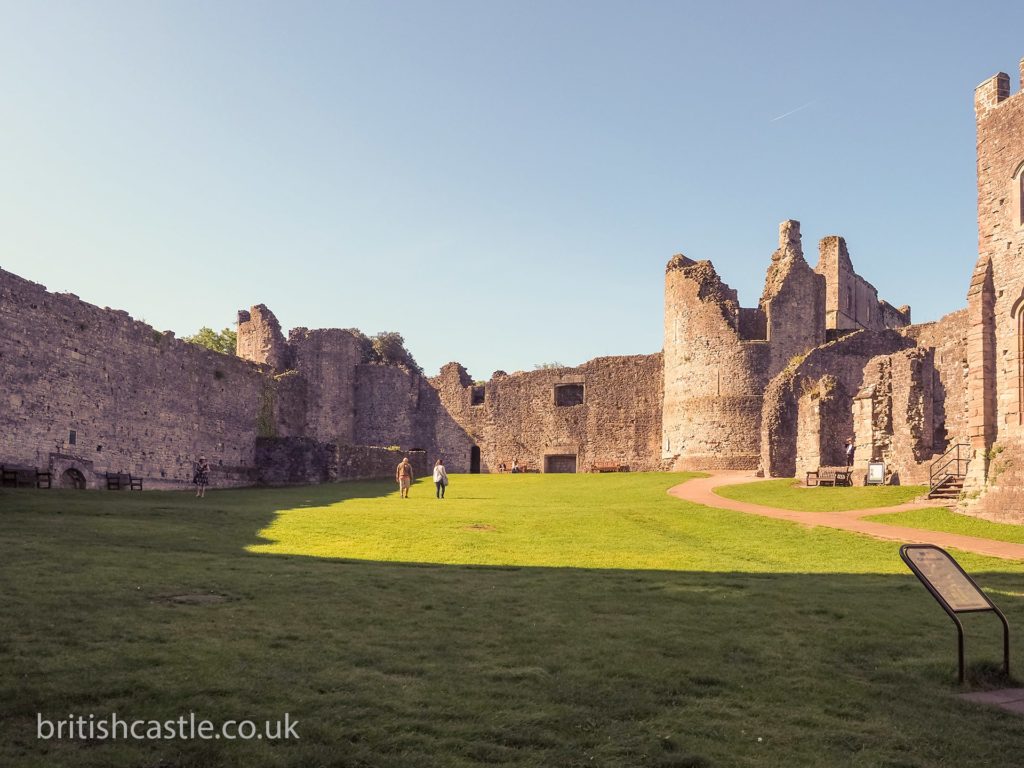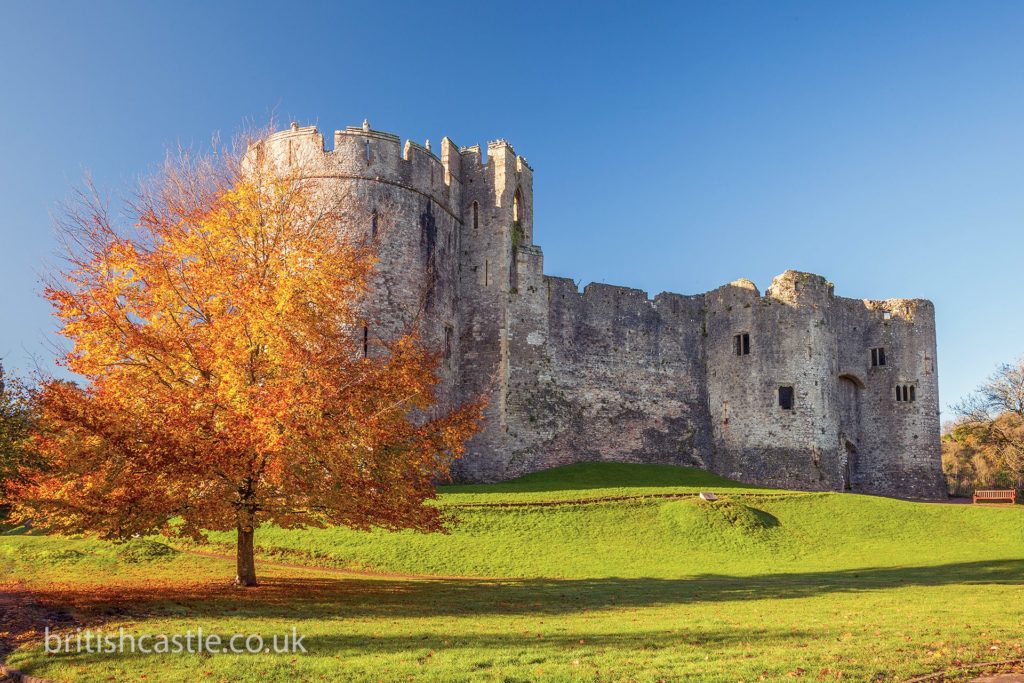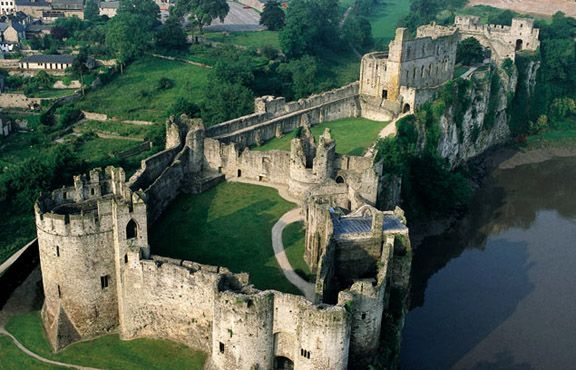As you will come to discover, Chepstow Castle (also known as Castell Cas-gwent, in Welsh), which sits in Chepstow, Monmouthshire in southeast Wales, just above a limestone cliff on the River Wye near the English border, holds a number of records. Most importantly, it is the oldest surviving post-Roman stone fortification in all of Britain. And, as such, Chepstow has borne witness to some of the most pivotal moments in all of history.

Chepstow Castle has remained relatively intact for close to 1,000 years, and is a stunning example of Norman architecture, as well as a solid example of grandiosity and medieval ambition––owing mainly to the stature and wealth of its owners over the years, some of whom remain history’s most powerful. Having experienced many building phases, the magnates and building operators of Chepstow Castle have ensured the preservation of this mighty home.
William FitzOsbern and the history of Chepstow Castle
Following the Battle of Hastings in 1066, in which he fought with his cousin and dedicated companion, William the Conqueror––who was subsequently crowned King of England––FitzOsbern was given several designations, including Earl of Hereford, one of the first peerage titles bestowed in the English peerage. One of the original and most ardent advocates of the invasion of England, FitzOsbern was a loyal adviser to King William and was assigned various roles throughout the latter’s reign, most significant of which was castle building.
This assignment was likely bestowed because of his penchant for founding a number of monasteries within the French Normandy region, along with his wife, Adeliza de Tosny. Including Cormeilles Abbey, Saint-Evroul Abbey and Lyre Abbey.

FitzOsbern was a force during Norman control of England and Wales and, as such, built a wide array of fortresses throughout both regions. Some of the earliest buildings that have been attributed to his creation include Wigmore Castle and Clifford Castle in Herefordshire, Berkeley Castle in Gloucestershire, Monmouth Castle in Wales, and in what was his primary residence during his lifetime, Carisbrooke Castle on the Isle of Wight.
FitzOsbern was also known to have provided improvements to fortifications in the towns of Shrewsbury and Hereford––the latter of which, like Chepstow Castle, lies on the River Rye.
For all his prolific architectural work throughout western Europe, his was a short-lived life, ending in Flanders during the Battle of Cassel in 1071.
Chepstow Castle lies on the River Wye in Monmouthshire, and was built by William FitzOsbern in the period immediately following the historic invasion of William the Conqueror in 1066 and the great sweep to the west to attack and subdue the Welsh.
FitzOsbern, who died soon after in 1071, was the Lord of Breteuil in Normandy and was given the lands and title of the Earl of Hereford by the Conqueror to underpin his invasion of Wales. Following FitzOsbern’s death the castle passed to his son Roger de Breteuil. It subsequently passed to Walter Fitzherbert in 1115, to his nephew Gilbert Strongbow, and then to Strongbow’s son Richard.
The Great Hall and the construction of Chepstow Castle
Construction on Chepstow Castle began around the time of one of the most famous events in English history––the Battle of Hastings in 1066, after which the victorious Normans maintained a firm political impact on Britain, coinciding with cultural changes that were felt throughout Europe. Less than a year after the bloody battle, led by the Norman monarch, William, the Duke of Normandy (also known as William the Conqueror), building commenced on a Welsh stronghold that would become a key launching point for future expeditions.

Two of Chepstow Castle’s most intriguing and unique features are its dramatic, cliff-side positioning over the water, and the Great Hall––the beating heart of the fortress, which still survives and offers one of the few remaining examples of original Norman touches.
While Chepstow Castle has been enlarged and improved by a series of hands throughout the centuries, it currently stands in a traditional Norman layout, characterised by a large rectangular structure, with an equally large gatehouse and high curtain walls looming over the nearby towns––all of which are connected by a series of monstrously tall towers.
The castle acted as a staging post during the long period of invasion, and is the oldest surviving example of a stone fortification of the Norman period. Above the doorway you can see the eroded remains of a Roman arch from a settlement that would have existed in the immediate area three to four hundred years previously, and the castle was developed and extended from the original Norman tower to the massive fortress you see today.

The format is terraced, not concentric (as is typical of many of the Welsh fortresses that would populate the landscape 200 years later as part of the Castles and Town Walls of Edward I in Gwynedd). However, what is typical for castles built at the time was Chepstow’s staged construction alongside, with great access to, the River Wye.
Not only a strategic location for defensive measures, but the water also served as a gateway for supplies, ensuring that the inhabitants were adequately equipped for battle, while also providing an escape route.
Chepstow Castle’s strategic position at one of the main river crossings between southern England and Wales made it a valuable site throughout the ages, and it became the hub of administrative and military governance for the Striguil (Chepstow) area.
Its position on the River Wye also made provisions deliverable by boat, a facility particularly important during the periods of siege and assault by the Welsh when transporting provisions across land would have meant risking their being ambushed by the Welsh.
William Marshal, Earl of Pembroke
After standing for nearly a century without issue, Chepstow Castle eventually changed hands and ended up in the possession of a man heavily versed in military architecture––and almost as prolific a builder as William FitzOsbern. Only this next William would bring the Welsh stronghold forward and build it up to a new standard of defensive capability
In the 1190s, Chepstow Castle passed into the hands of William Marshal, Earl of Pembroke, by way of marriage. Much like the renovation work he undertook with Pembroke Castle in 1189 (which also came to him, along with his Pembroke title, via his marriage), Marshal used his immense knowledge of warfare design and added fortifications to Chepstow Castle to not only modernise the existing structure, but to further protect it from insurrectionists.

He not only built the main gatehouse (which exists to this day), but he also rebuilt the east curtain wall, adding dual towers that projected outwards to provide added defensive protection to the fortress’s unguarded side. The two towers were outfitted with arrow slits which would allow inhabitants the opportunity to give covering fire to the units on the ground at the front curtain, a defensive feature that would become a new medieval standard in military castle design. But the Marshals weren’t done.
Around 1245, William’s sons took over and began enlarging Chepstow Castle’s layout––improving accommodation floors inside the hall, adding a new lower bailey with gatehouse, and constructing additional defensive measures to the keep, including a solid barbican.
The additional fortifications and improved interior provided a formidable defence against repeated but unsuccessful Welsh onslaughts. Notice that at the rear of the castle, which faces into Wales, there are no windows, whereas the front of the castle, facing England, allows in plenty of light.
By 1270, Chepstow had been inherited by Roger Bigod, the fifth Earl of Norfolk, who was a direct relation to William Marshal. Bigod constructed further buildings and accommodation suites to the fortress, as well as constructing Chepstow’s town wall, known as the “Port Wall”, from 1274-1278, followed by a new tower known today as “Marten’s Tower”.
Although it is likely that the windows were enlarged in later periods, clearly this building design proved to be a remarkably strong and durable defence against attack.
By the end of the thirteenth century Chepstow Castle had passed to William Marshal, a soldier who became the Earl of Pembroke by marriage.
The castle underwent further development in the Tudor period and by the time of both Civil Wars was fought for by both Royalists and Parliamentarians.
Chepstow Castle throughout the years
Despite significant battles and numerous siege attempts (some successful, others not) fought at Chepstow Castle throughout the centuries, there were only a handful of subsequent renovations performed, nearly all of which were as a pre-emptive reaction to the modernisation of weapons.
Like many of the area’s fortresses still in existence at the time, Chepstow Castle was a focal point during the Welsh Rebellion of 1403, led by Owain Glyndwr. However, unlike those same fortresses, Chepstow did not see much action. As a response to the uprising, the powerful fortification was garrisoned with a large defensive army, which included sixty archers. Ultimately, due to its size and location (and likely the size of the garrison), Chepstow avoided attack.
Chepstow Castle changed hands again during the 15th and 16th centuries, passing through as a granted estate to the likes of William Herbert, Earl of Pembroke, and later to Sir Charles Somerset, Earl of Worcester. Remodelling work was undertaken for the purpose of greater private accommodation facilities, but the site remained relatively obscured from battles.
But this obscurity would not last for long, as the English Civil War erupted in 1642 and Chepstow Castle, held by the Royalist Cavaliers, was besieged in both 1645 and 1648, falling to the Parliamentarian Roundheads. Following this period, Chepstow was garrisoned and used as a political prisoner for dissidents––but not before the southern face of the castle was reinforced with stone and earth as prevention against additional cannon fire. Eventually, the garrison was disbanded, the prisoners removed, and parts of Chepstow’s fortifications were dismantled and left to rot because of leasing agreements made to private tenants.
By 1690 Chepstow Castle was decommissioned and was left empty, falling into disrepair and ruin until it was sold by the Beauforts to the State in 1914. However, another period of rebirth would emerge for Chepstow Castle, owing primarily to its unique location.
Chepstow’s proximity to the River Wye made it an accessible outlet during wartime. In peacetime, however, nearby residents––and, eventually, visitors from afar––took note of the scenic beauty that surrounded the stronghold, nestled within the picturesque Wye Valley. So picturesque that Chepstow Castle became a popular destination for tourists navigating the Wye Tour, a famous excursion through various scenic buildings and monuments along the River Wye that was popular with British visitors between the 1780s up until 1850.
William Wordsworth famously wrote about the area in his famous poem, “Lines Written a Few Miles Above Tintern Abbey”, published in his collection Lyrical Ballads, in 1789. This marked the beginning of Chepstow Castle’s new life as a point of interest to holidaymakers and tourists, one that continues to this day.
The prominent courtyard at Chepstow Castle was the site of many historical pageants and horticultural shows during the 19th century. No longer a stable for political prisoners, the new structure was refurbished and put on display for visitors on steamboat day trips from Bristol. The final family to own Chepstow Castle was the Lysaghts who acquired the property in 1914, led by tycoon William Royse Lysaght who ordered extensive restoration and conservation work. Ultimately, the family entrusted the building to the Ministry of Works in 1953, following which Chepstow Castle was used, almost exclusively as a historical attraction and filming location.
In 1984, Chepstow Castle came under the ownership of Cadw, the Welsh Government’s historic environment division, which is responsible for the maintenance and general upkeep of all of Wales’ historic buildings. Chepstow Castle was also given the distinction of a Grade I listed building in 1950.
Today, Chepstow Castle is open to the public as a historical museum and visitor’s centre. It continues to be used as a filming location––you’ve likely witnessed it in music videos, feature films, and during scenes of the Doctor Who 50th anniversary television broadcast. As always, visitors can catch a glimpse along a hike through Wye Valley, while others can get up close and personal by spending the day traipsing the interiors or walking the battlements into Marten’s Tower.